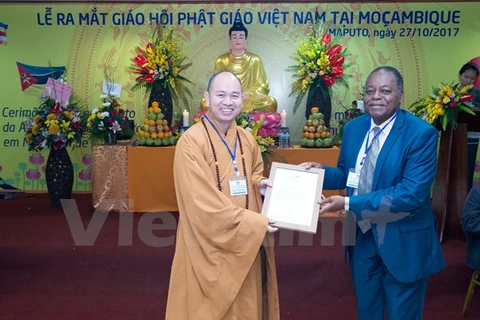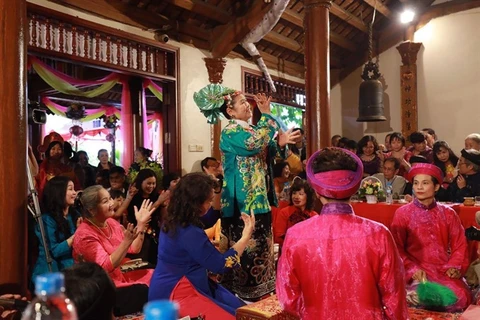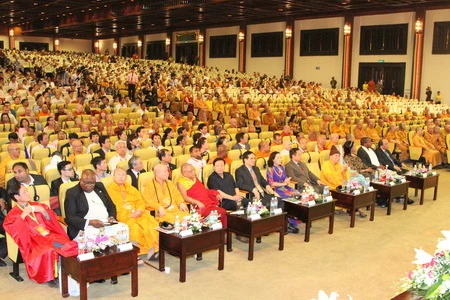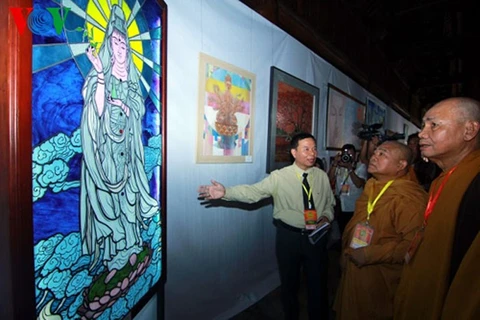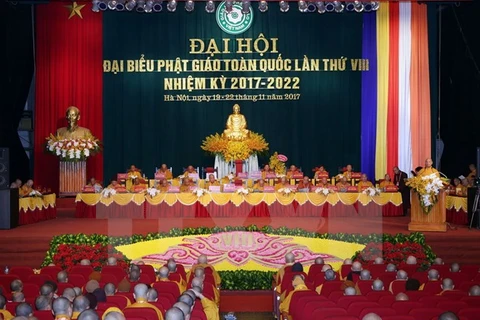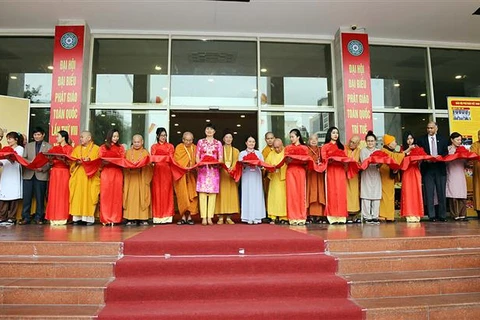Hanoi (VNA) – Since Buddhism entered Vietnam from India and China thousands of years ago, it has mixed with the nation’s traditions and beliefs, while contributing to shaping the nation’s cultural heritage.
Buddhism shapes Vietnamese cultural identity
Buddhism has made significant contributions to Vietnam’s culture, with its legacy prominent in the nation’s ethics, philosophy, literary, architecture, sculpture, rituals, and paintings, among others.
According to the Information Communication Committee under the Vietnam Buddhist Sangha (VBS), Vietnam now has more than 15,000 Buddhist worshipping establishments. Nearly 600 pagodas are recognised as historical relic sites, over 300 as cultural relic sites, 1,300 as historical and cultural relic sites, and more than 130 as architectural and artistic sites.
Many pagodas have become tourism destinations and architectural and spiritual symbols of the nation and localities, such as the One-Pillar Pagoda and Huong Pagoda in Huong Tich Cave, normally known as Nam Thien De Nhat Dong (the nation’s most sacred cave) in Hanoi, Dong Pagoda on Yen Tu mountain, Quang Ninh province, and Bai Dinh Pagoda in Ninh Binh.
He noted the significance of pagodas to community, saying that old pagodas witness ups and downs of people. Most community-based cultural activities take place in or around local pagodas, including festivals. Vietnam has nearly 8,000 traditional festivals held nationwide yearly, with most originating from Buddhism. Many have become renowned, such as Huong Pagoda Festival, Yen Tu Festival and Bai Dinh Festival, drawing millions of tourists and Buddhist followers. Buddhist Vu Lan Festival has been observed by Buddhists and non-religious people alike, Sau said.
The practice of worshipping both Buddha and ancestors on the first and fifteenth day of each lunar month has become a religious and cultural mark of Vietnamese people, he said.
Buddhism was localised under influence of Vietnam’s culture
According to Dr Tran Khanh Du, Director of the Centre for Preserving Religious Culture under the Government Committee for Religious Affairs, before Buddhism came to Vietnam, Vietnamese people mainly worshiped Holy Mothers, making it a favourable land for the new religion to grow. With careful selection and mingling, Buddhism has become localised. Therefore, Vietnamese Buddhism is, to some extent, different from general Buddhism or Chinese and Indian Buddhism, Du said, adding that Buddhist deities worshipped in Vietnam are described in ways that fit Vietnamese people’s belief and expectations.
 A Buddhist style wedding called Le Hang Thuan (Forever Together) at Sung Phuc pagoda in Hanoi (Photo: VNA)
A Buddhist style wedding called Le Hang Thuan (Forever Together) at Sung Phuc pagoda in Hanoi (Photo: VNA)Most Buddhist gods are loved rather than feared. Quan Yin, who is portrayed in different cultures as either female or male, is regarded by Vietnamese people as the goddess of mercy under the influence of the Mother worshipping. The deity was even woven into the Vietnamese folktale of Quan Am Thi Kinh (Goddess of Mercy), a Vietnamese nun named Thi Kinh, who, through great love and sacrifice, attained Nirvana Buddhahood. She was worshiped as a Vietnamese goddess for her integrity, dignities, and spirit of self-sacrifice.
 Vietnam's biggest Thi Kinh Quan Yin in Phuoc Quang pagoda, Vinh Long province (Photo: coutesy of Head of Phuoc Quang pagoda)
Vietnam's biggest Thi Kinh Quan Yin in Phuoc Quang pagoda, Vinh Long province (Photo: coutesy of Head of Phuoc Quang pagoda) The Buddha himself has also entered Vietnam’s folk culture as a gentle and kind old deity called “But”, who always appears to help disadvantaged people and their sufferings. The Vietnamese Buddha has also featured in folk songs, chants and fairy tales.
The Vietnamese people even have their own Buddha. King Tran Nhan Tong (1258-1308), the third king of the Tran dynasty, had huge influence on Vietnam’s view of Buddhism. The King ceded his throne at the age of 35 after 15 years in power, and spent the rest of his life on the Yen Tu Mountain practising and propagating Buddhism. He founded Vietnamese Zen Buddhism called Truc Lam Yen Tu with minimal amounts of transition from traditional Chinese Buddhism. The King-Monk also worked to unify different Vietnamese Buddhism sects into Vietnamese Zen Buddhism, Du said.
Meanwhile, Dr Dang Tai Tinh, former Director of the International Cooperation Department under the Government Committee for Religious Affairs, highlighted the tolerance of Vietnamese culture, saying that it tends to protect its identity, yet is open to positive influence from foreign cultures.
Many international delegations from Buddhist nations have been surprised at the fact that Vietnamese pagodas are not just dedicated to Buddhist deities. There are different altars at each pagoda, worshipping Buddhist deities, Mother Goddesses, even national heroes. Establishments of different religions, such as churches and pagodas coexist in one area without disputes. This reflects the unique characteristics of Vietnamese Buddhism and the freedom and harmony in religious practices of Vietnam.
Tinh also emphasised the way Buddhism has mixed well with the ancient ancestors worshipping and practices of the Vietnamese people. The Buddhist Vu Lan Festival is celebrated in tandem with the Vietnam Mother’s Day, when children express their gratitude towards their parents (especially mothers) and help ancestors’ souls find their way back to the earth, he said, adding that it has also become an annual large-scale Vu Lan Veggie Festival, inspiring vegetarian culture and environmentally friendly life style.
Buddhism upholds national patriotic tradition
In an interview with the Vietnam News Agency (VNA)’s correspondent, Most Venerable Thich Thanh Nhieu, Vice Chairman of the VBS Executive Council, highlighted the strong attachment Buddhism has developed to Vietnam, saying that the religion weakened during the nation’s colonial period and thrived with peace and prosperity in the country. It was considered the nation’s religion for the Ly Dynasty (1010-1225) and Tran Dynasty (1225-1400), when pagodas were built and upgraded nationwide and many kings became Buddhists.
He also underlined the patriotic tradition of Vietnamese Buddhism. During the resistance war against the US imperialists, many pagodas became bases or shelters for revolutionaries. Patriotic Buddhists stood by the nation and joined the revolutionary movement, shared sufferings and hardship with all Vietnamese for the cause of national liberation. Late Most Venerable Thich Quang Duc, who lit himself on fire to protest the war, encapsulated the revolutionary nature of the southern Vietnamese Buddhists in the 1960s.
Many dignitaries have participated in the nation’s political system, including the National Assembly, the Vietnam Fatherland Front Central Committee, local People’s Councils, and socio-political associations. They have also joined patriotic movements, charity work, poverty reduction, environmental protection and climate change adaptation.
Annual requiems have been conducted to pray for peace for fallen soldiers in many cemeteries nationwide, including Con Dao, Phu Quoc, Truong Son, Quang Tri and Dien Bien cemeteries, Most Venerable Thich Thanh Nhieu said that the VBS considers this one of its key tasks, showing respect and gratitude to martyrs who died for national liberation and defence.
In an interview with the VNA’s correspondent, Dr. Bui Huu Duoc, head of the Buddhism Department of the Government Committee for Religious Affairs, said Buddhism has been growing fast, with the number of Buddhist followers rising to nearly 40 million people, more than 40 percent of the nation’s population.
The VBS has chapters in all 63 provinces and cities, hundreds at district- and commune-level nationwide, and Associations of Vietnamese Buddhists in 11 countries worldwide. There are four Buddhism universities, eight college-level training programmes and 34 primary Buddhism schools.
The Party, State and Government have facilitated the development of all religions, including Buddhism. Their practices and outstanding contributions have always been recognised. The VBS was granted with a first-class Labour Order by the Party and State on the occasion of its 35th anniversary in 2016.
Buddhist dignitaries, monks, nuns, and followers have been uniting and standing by the nation and its people, making significant contributions to the nation’s Doi Moi (reform) as well as the cause of national construction and protection, thus enhancing Vietnam’s reputation on the international arena, Duoc reiterated.-VNA




